#tankobon volumes
Text
BTS (behind the scenes) for some SAKAMOTO DAYS volume covers VS the actual volume covers:


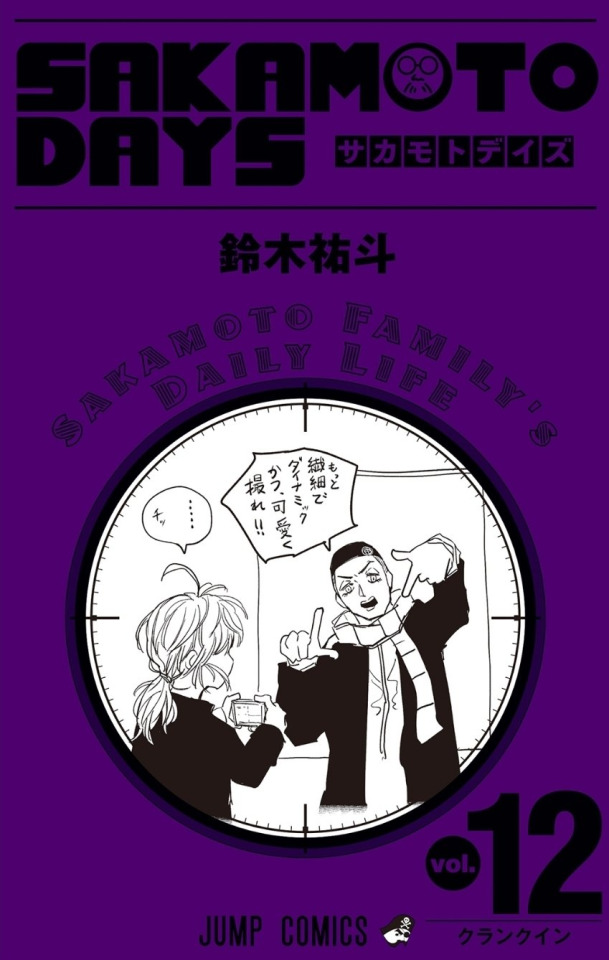



#サカモトデイズ#SAKAMOTO DAYS#manga volumes#manga volume covers#slur#uzuki#kashima#kanaguri#akira akao#hyō#nagumo#tankobon volumes
100 notes
·
View notes
Text
JJK 207 leak thoughts
on the one hand, akutami doesn’t kill off characters if it’s not interesting/their story isn’t over + Kenjaku is millenia old with what 3 Techniques? He was bound to get one over on Yuki at some point.
at the same time
Akutami is never beating the misogyny allegations
#jjk manga spoilers#jjk 207#skipping these chapters until something different happens#rn I think he’s just filling out a tankobon volume with this fight#which…fair#kambili x jjk
24 notes
·
View notes
Text

this fucking guy
#mid trimax i love you#it's so awesome. like five tankobon volumes worth of the exact moment of the kiss of judas#'i know that you know that i know that you know' x2
3 notes
·
View notes
Text
Look what got here today!

I'm probably going to take the black banner along the bottom off, but the cover under the dust jacket has no pattern (not unusual tbh, they're kinda designed so you can easily take them anywhere without drawing too much attention to what you're reading) so I'm planning on keeping the jackets on
This is what I mean by "no pattern". No Longer Human (left) doesn't have one either, but it does have a cute lil design (my Flower Language Dictionary has a crane I think).
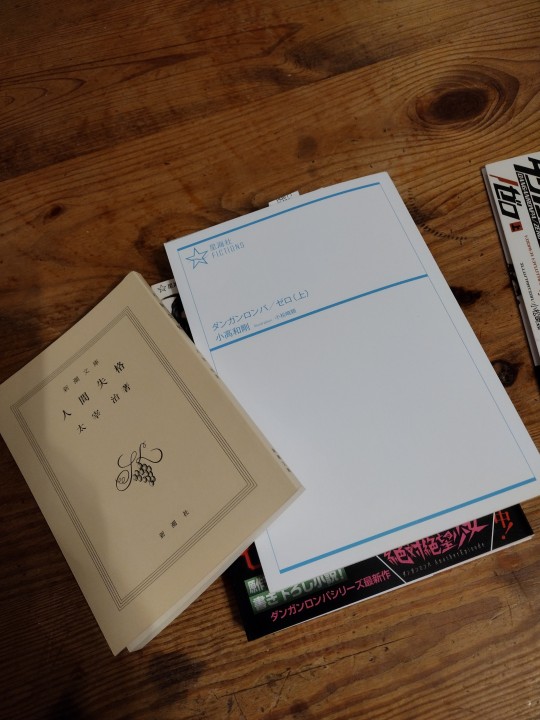
Also if you ever need a visual reference for the size difference between bunkobon and tankobon, here ya go

1 note
·
View note
Text
Considering doing a (very rudimentary) write-up of Kagurabachi volume 1 once the next chapter drops. Probably just a little dive into the world's technology, bits of worldbuilding, and character study.
#idk when volume 1 tankobon drop in jp#but i'm compelled to pick it up via proxy when it's available#since i'm not expecting english volumes to be announced for at least. idk. a year?#early manga story arcs are a treat to explore#that is. if there's a guarantee to avoid the axe entirely and become a mainstay#it's all about viewing the development from a distance#and see the potential for layers#that can be peeled back to reveal the expanse underneath#i'm not expecting this to have one piece levels of worldbuilding#that's its own beast#but i do think the potential of it being a world that's 'lived in' - like naruto's - is much stronger rn#manga#armi reads manga#tbf i probably should've done something like this like. maybe a couple weeks ago#but it's the thought that counts
0 notes
Text


not even going to bother with showing these covers to my mom man
#i ordered the first volume because. i had to#and then volumes 5 and 6 because theyre my favorite chapters#IF youre curious these are the tankobon volumes (200p 18cm tall)#i wanted the bunkokan volumes (300p 15cm tall) because they have prettier covers but they were out of stock believe it or not#eroica is still in high demand!
1 note
·
View note
Text
i'll wait until part 2 chainsaw man ends before i buy the tankobon
#honestly i want at least one volume in my hand that'll be crazy nice#also jump's tankobon is pretty cheap compared to other publishing's package so i know i can afford it#but i'm gonna wait until part 2 ends so i can decide what volume has the most memorable scene that i need to keep in my hand#tmi tag
0 notes
Text
Babe wake up the new cover for Moriarty the Patriot -The Remains- Volume 2 just dropped!!!
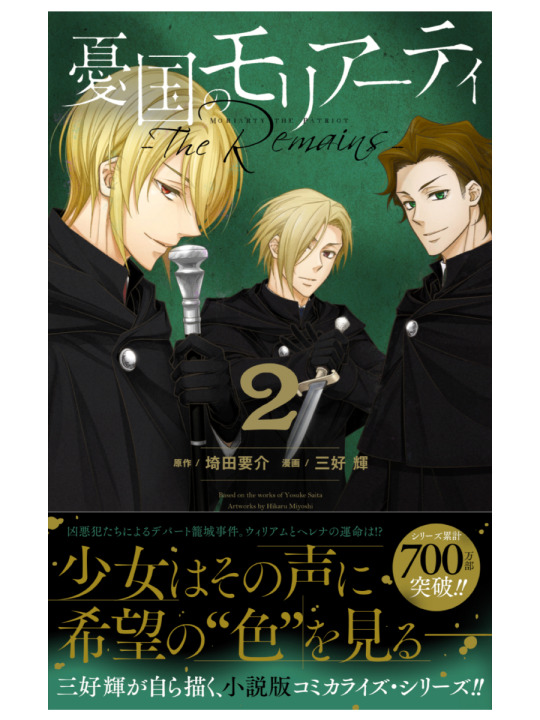
The new volume will be released on February 2nd 2024 at 12AM JST! It comes with two different illustration cards if you purchase from Animate or Kikuya. We're also getting another high school AU bonus chapter! You can see the preview on Miyoshi Sensei's tweet here.
Together with volume 2, chapter 11 of The Remains is also released at the same time in the March issue of Jump SQ, where we'll be getting a colour page!
If you want to get your own copies of the tankobon and magazine, you can check supportyuumori.carrd.co where I listed some foreigner-friendly websites to purchase from!
Thank you for supporting Moriarty the Patriot💗
#moriarty the patriot#yuukoku no moriarty#yuumori#william james moriarty#louis james moriarty#albert james moriarty
212 notes
·
View notes
Text
Urusei Yatsura artists! Draw this in your style (DTIYS)!!
The poll has ended and the results are clear, so here it is: The UY DTIYS challenge!!
Remember! Anyone can do the DTIYS no matter what your skill level is or whatever the quality of your supplies are; and there is no due date for the DTIYS, so even if you think of attempting it months or even years later, you're completely free to do so!
And with that aside, here it is, the art to be redrawn!
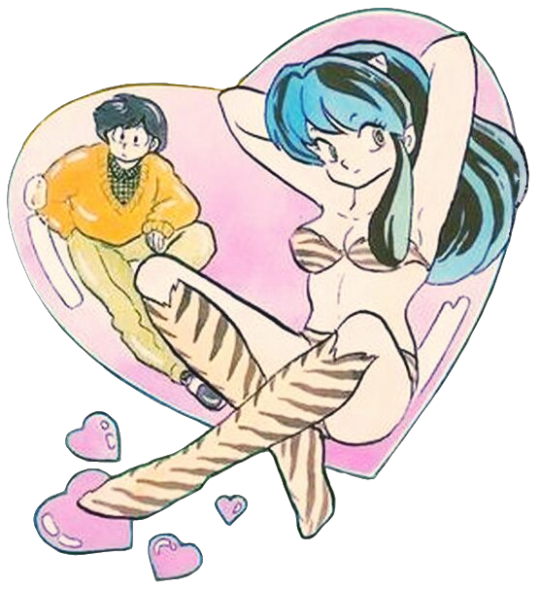
Illustration from the cover of Urusei Yatsura Tankobon Volume 33.
A very good luck to all the artists who will be doing the DTIYS, I honestly can't wait to see your work! ( ^ω^)
And of course, reblogs for this post are appreciated since it may allow more people to know about this and if you have any queries, feel free to ask! :)
#queueing this as early as monday since the poll is way too obvious at this point#and just in case im unable to be online the day i promised to post this#(also im not the best at cleaning images so please forgive me if it doesnt look good!!)#anyway good luck yall!#urusei yatsura#うる星やつら#urusei yatsura 2022#lum#ataru moroboshi#atalum#and its just in time for valentines huh?
116 notes
·
View notes
Text
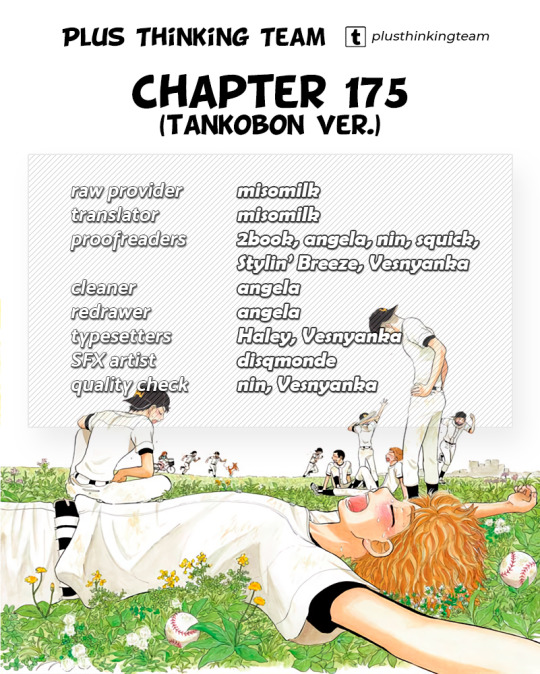
✦ CHAPTER 175 (TANKOBON VER.) ✦
Links to the Chapter: Imgur | Mediafire | Mega
Credits
raw provider: misomilk (misomilk)
translator: misomilk (misomilk)
proofreaders: 2book4people, angela (unlshthfrckngbt), nin (ninthebin), squick, Stylin’ Breeze (stylinbreeze60), Vesnyanka
cleaner: angela (unlshthfrckngbt),
redrawer: angela (unlshthfrckngbt),
typesetter: Haley (oofuri2003), Vesnyanka
SFX artist: disqmonde
quality check: nin (ninthebin), Vesnyanka
A note on magazine vs tankobon:
This version of chapter 175 is from the latest tankobon of Oofuri: volume 36. Our team has decided to scanlate both the magazine and tankobon versions of each chapter so that readers can have a complete archive and compare versions. Since the tankobon chapter is meant to be the final version, we’ll be replacing the magazine versions on Mangadex as we work through the new volume. However, both will be available here on our Tumblr. Please enjoy this fresh edition of chapter 175!
38 notes
·
View notes
Text
SAKAMOTO DAYS Volume 15 “The Assassin Exhibit of the Century” cover

Source: Sakamoto_Store official
Volume 15 releases in Japan on 4th of January 2024.
#kumanomi#サカモトデイズ#SAKAMOTO DAYS#official media#tankobon volumes#manga volume covers#yūto suzuki#sakadays
18 notes
·
View notes
Text
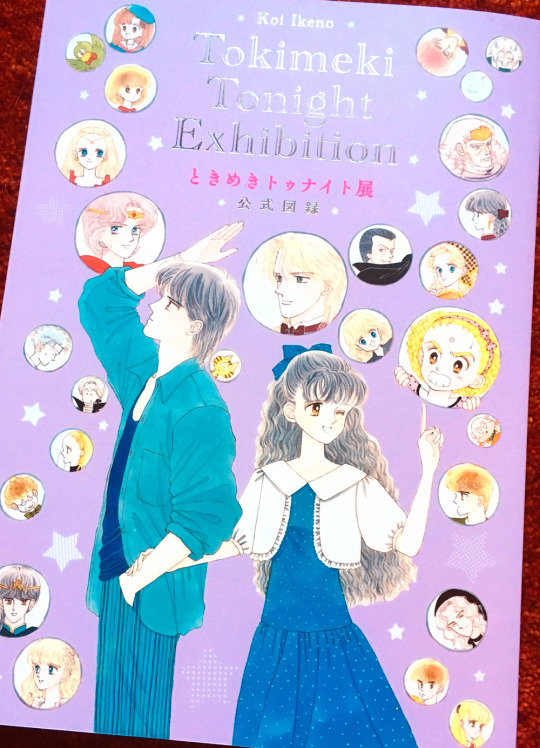
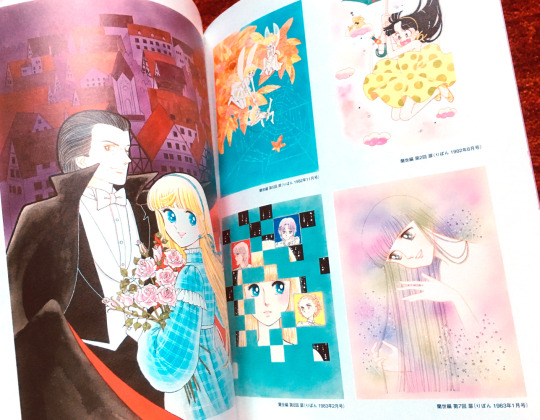
💕💗❤️🥰❤️💗💕
The print quality is beautiful and it includes WAY more than the 300 pieces of art they promised! I'm very very happy to own it and so grateful the exhibition made Shueisha get off their lazy butt to put this together.
As expected, the selection of art focuses largely on title pages. It includes almost all Narumi and Aira title pages, which is lovely, but there are a LOT of Ranze title pages missing, which I have to ascribe to the original manuscripts having been lost (like Ikeno has told her fans in private multiple times).
16 of the missing Ranze title pages were reprinted in the 1987 furoku "Memorial scene collection", so my theory is they were all lost in the process of printing this furoku, and the ch. 4 title page might have been lost when it was reprinted for the "Anime special issue" magazine. This would also explain why the Italian edition uses different cover art than the Japanese tankobon edition for volumes 2 and 9! I've been wondering about that for a while. If this is true, a ton of beautiful, wonderful art has been lost. :(
Other titles pages which were not included: Ranze ch. 1 (included in the Tokimeki manga-michi tankobon), ch. 21, ch. 22, and side story Christmas no okurimono (included in the Romantic Album fanbook); Narumi side story Ginga romance no yoru ch. 1; Aira ch. 20, Aira side story Poteto no Merry Christmas. Ribon covers which were not included: Aira cover of Ribon bikkuri zokan early spring 1993.
Of these I'm missing Ranze ch. 22 and Ginga romance no yoru ch. 1 in my collection, so I'll make it a priority to pick up the relevant magazines in the near future.
Other than that, there are six pages reprinting a more or less random selection of furoku art, a smattering of black and white manuscript pages, and three pages (one for each arc) reprinting preview illustrations, magazine spine illustrations, novelty phone card illustrations, and other rare and beautiful art, which might be some of my favorite pages of the whole book <3 I absolutely adore Ikeno's preview illustrations, so much cuteness and beauty crammed into such small spaces! These pages are a must see and must own for fans. The interview with Maki Yoko and Mochida Aki is fine, not particularly insightful but you can tell they're both genuine fans of Tokimeki and of Ikeno's art.
One glaring omission from this book (aside from the Ranze title pages) is the numerous rough sketches that were displayed at the Tokyo venue of the exhibition -- only five of them are reprinted here. Just more reason for people to go to the venues though, because holy molly those were absolutely amazing!!! I really hope they'll be displayed at the Kyoto venue too, so I can take pictures of every single one of them.
But all in all, this is a wonderful book. If you visit the exhibition, or if/when it goes on sale online, you should definitely pick it up -- it's a masterpiece of 80s and 90s shojo art!
74 notes
·
View notes
Text
0-6!
(If you’re wondering how I’m getting these done so fast, it’s because I’m doing these ahead of time. I'm running on a queue.) I used dictation and actual keyboard typing for this one, so it’s going to be long. (Side note, I love the ability to dictate things and using split screen mode! Highly useful features and I have no idea why it’s taken me this long to actually use them.) Also, I guess I should say that there will be spoilers in this and probably future posts too, because I’ve already read the manga. Okay! Onto the commentary.

I love that Saiki outright states he doesn't want to be the "guy you know what he's thinking.” Like, come on Saiki, admit it; you have a little bit in common with Kaidou. (I think he secretly kind of likes freaking people out. He definitely likes the fact that people are a little scared of him.)
He's always the odd one out; He's one of the loner kids. I don't think he really thinks it makes him look normal. I think that's just what he tells himself to feel better about the whole thing.

I think it's funny that he dislikes Kaidou for the same reasons that he thinks he's so different from everyone else. I mean, Kaidou is always trying to stand out, and Saiki does have a legitimate reason for not wanting to stand out. But even so. He’s just got it in his head that is so much better than Kaidou at the beginning of the series. Like, dude, you're no different from him. You're the same breed of weirdo in a different font. Lol. That font is “really intentionally manipulating others’ perception of you for personal reasons.” It’s just that Kaidou’s version is much flashier than yours. I like seeing it this early on in the comic; it's interesting to see how it all started. Also, Kaidou is a lot more polite than Nendou, apologizing for talking to Saiki out of nowhere. Amusing. He absolutely knows how to behave like a normal person, but chooses not to because his persona gives him confidence.

I also like that here in the beginning of the comic, we have an unnamed guy who is was basically parroting what Kuuusuke says further on in the comic, and it’s more clearly framed as delusional weirdo behavior.

Yes, duh, he came to you because you were alone, Saiki. Weirdo behavior attracts weirdos (weirdos attract weirdos.) That's just a basic social law for ya.

Also, I laughed out loud at “okay, I’m calling you Junpei.” good response, honestly. Saiki’s narrative commentary addressed to no one in particular is always really funny.
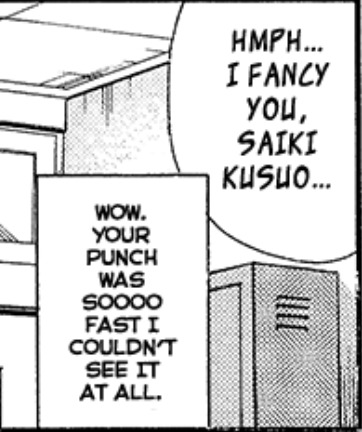
He also seems to be egging him on in the next panel with his sarcastic remarks (wow. Your punch was soooo fast I couldn’t see it at all), though it’s never clear in this manga whether the person being spoken about can actually hear anything he’s saying in all of its dry sarcasm. My headcanon follows the lines that Saiki uses hypnosis when he’s not actively addressing them (sending telepathic messages to them), so people just hear whatever they want to hear from him. Or something like that. I’m guessing that we, the readers, are supposed to assume that they can’t hear him unless Saiki is actively sending them telepathic messages/‘broadcasts’. "I fancy you" is a strangely British way of putting it. Which also means "I like-like you" if memory serves. Translators??? strange. anyways.

Ah… XD. I forgot that Kaidou saw him teleport in the manga. That’s perfect considering Kaidou’s name joke (shunkaidou = teleportation.) wahh, I wish this one came in the tankobon volumes so I could read them.
You know… since the third chapter of this volume was adapted into the anime, can volume 0 really be called non-canon? Maybe to the manga. Hmmmmmm.

Oh come on. Why didn’t they put this in the anime??? It would have been hilarious to have Kaidou imagining some kind of green monster-humanoid hybrid and then the screen transitions to Saiki’s expressionless face, with pink limiters and green glasses. There’s an element of color that manga sadly lacks. I get the point with the black arrows, Mr. Asou, but it just isn’t quite the same without actual color.

XD Asou’s attention to detail is good. We actually see the teacher wondering where the hell he’s going when he runs out of the room, and then following through showing that he won’t be running students down just to make sure they stay in class. It’s a small thing, but it definitely makes a difference, making the Saikiverse seem a bit more realistic.

Also, look, it’s this guy who appears a bajillion chapters later in that weird gag… What was his name again? Gah… refer back to this later, future me.
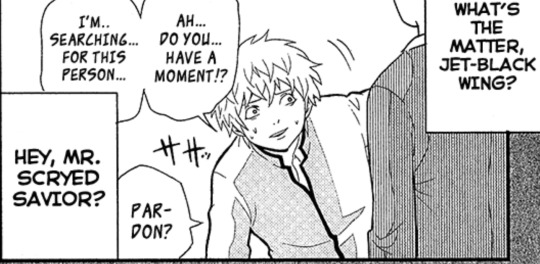
Yes, Kaidou becomes a completely different person outside of his riddiculous chunnibyou persona, which he only uses at school. I do like that Asou sensei writes him this way. It would be easier to have him be in character all the time, but he’s much more realistic like this. I love that Saiki remembers the stupid nickname he gave himself. It makes the contrast even more funny. Okay, I’ll stop analyzing Kaidou and explaining every joke for now.
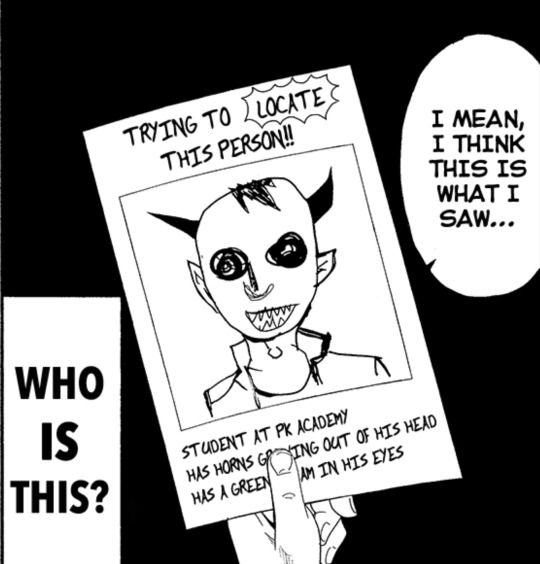
XD XD XD

Things like this make me wonder if Saiki really doesn’t know that’s how his looks might be interpreted at a distance… even though he understood from the verbal description that he could be perceived as having “pink horns” and “green eyes.” And he spaces out in class just thinking about it. Thoroughly neurodivergent behavior.

I also love things like this, that imply but don’t outright show that Nendou just… openly teleports in front of Nendou because he can get away with it.

I also enjoy Saiki’s stubbornness in calling Kaidou ‘Junpei.’ Peak comedy.
I love that Kaidou would rather Saiki think he has multiple personalities instead of just being polite to people outside of school. And Saiki says he appreciates the effort… lol. I think he does actually appreciate it, in a way, sarcasm aside. Kaidou is committed to the bit.
“Whether that’s true or not, you need to get to a hospital.” Lollll. But also… makes me wonder if he really believes it, again. That along with the “Kaidou personality chart” further on in this comic. From Saiki’s other confrontations with people who clearly need help (including the one where he talks down a suicidal guy. And of course Terushashi’s brother.) It’s as if it never even occurred to saiki to have a sense of urgency about these kinds of things.

Mmmm! Once again I wish I had the Japanese version because I’m sure he is using polite speech here, for a minute.
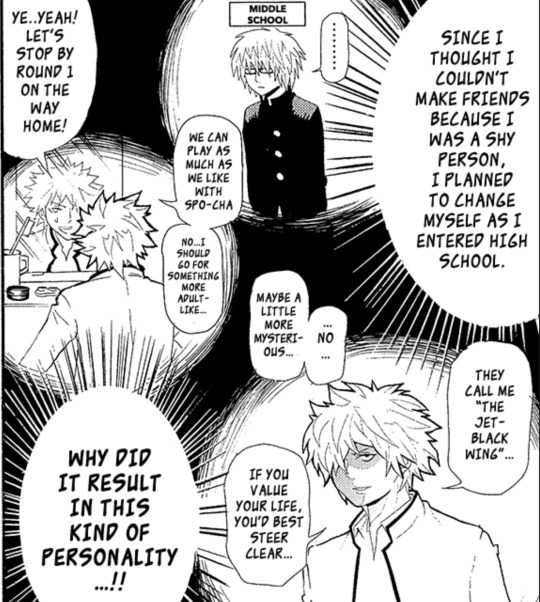
Well, at least Kaidou acknowledges here that he’s in fact a chunni and therefore doing this on purpose. Which, again, makes me wonder why Saiki would ever believe even for a second that it isn’t an intentional thing. Or maybe it’s just supposed to be taken as sarcasm outright, but the panel where Saiki is confused about the Horns Saiki drawing really is throwing me off. Another thing I should look for raws of, to see if there’s anything to be gleaned from the OG text.
YES! You and saiki are pretty similar. In a way. Yes, he is worrying about his high school debut… in a way.
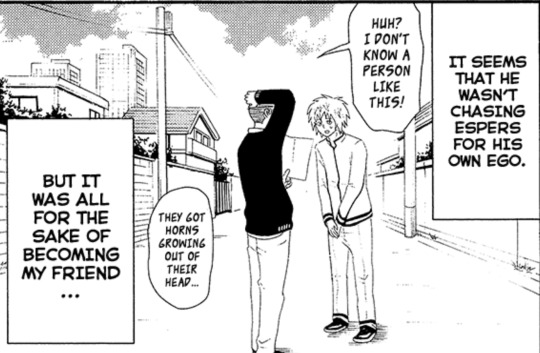
Saiki, it is entirely understandable that you think Kaidou is an egomaniac, but given his “other personality,” how did you not guess that he’s just lonely??? He literally had to explain his entire thought process for you to get it??? Yeah, emotional EQ in the single digits.
Earlier, I said Kaidou knew full well how to act like a normal person and just doesn’t do it, but he’s definitely awkward. I mean, of course it’s going to be awkward asking strangers if they’ve seen a guy with green eyes, sharp teeth and horns. (I am not quite sure why Kaidou is so committed to the bit myself.)

LMAO?!?

Saiki, that’s your own goddamned fault, lmao. Put your money where your mouth is and shut him down if you’re tired of annoying people “entering your life”…
:)
That wraps up 0-6.
There’s a lot going on here, to be sure. In conclusion, I think Saiki works really well here as a character who is technically omniscient, in terms of perspective, but deeply limited in his ability to interpret information.
Alright, the end. Ja mata! 💫
#queue#read-saiki#read saiki 0-6#just to be clear. I love saiki. I am not dissing him#Saiki k#long post#if i were borderline omnipotent i also would use my powers for stupid stunts like these#to both freak people out and make their day somehow#i guess sometimes it’s a 50/50 unless you’re dealing with a kaidou level weirdo
22 notes
·
View notes
Text
Marianne's Past


I went and read the Marianne vi Britannia chapter from Mamoru Iwasa's "Knights of the Round" short story anthology that was released as a bonus volume to his Code Geass R2 novel series.

I am 80% sure that this image that is often seen floating around online was made to promote this specific short story (or maybe accompany a serialized release?), but the illustration itself is not included in the tankobon release.
I'll provide summary of the short here here, but please be aware I am reading with machine TL and there may be errors even despite the best of my double-checking. If you want these details for, idk, academic reasons please go to the source text first!
Anyway this story rules, here it is. Italics mark direct quotes.
We start off strong with Charles thinking "I had no reservations about wasting my own life." Standing in the middle of a battlefield, he laments that Britannia is a dying country structured around a bloodthirsty elite. No dreams, no hope.
"Born into such a world, why would you desperately try and such a small thing as your own life?" he thinks, but then Marianne's voice cuts through to him. Marianne waltzes into the room where Charles stands surrounded by soldiers pointing guns at him. Injured, in her bloodstained white uniform, she fights her way through to him with unbelievable competence and elegance. She beheads all the men as the narration describes the beautiful glisten of her sword and the flow of her hair.
Marianne, the Knight of Six at this point, sheathes her sword and bends the knee before Charles, in the middle of corpses and with both of them splattered over and over in blood.
"I sincerely apologize for any trouble I've caused you by being late," she says.
Marianne tells Charles to evacuate, but he remains stoic and only looks at her arm, which is rendered unmoving by her injury.
"That wound. You've killed, Knight of Six. You've killed the Empire's most powerful knight, the Knight of One."
Only he would have been able to hurt her this badly, Charles reasons.
The Knight of One turns out to be the person who staged this rebellion in the first place and Marianne did indeed kill him before coming to find Charles.
We learn that Charles' reign is being questioned by conservatives because he was such a distant candidate for the throne originally and ascended mostly due to the past emperor's insistence.
"There is external trouble, and the internal anxieties are becoming more and more serious. This a country on the verge of ruin. Don't you agree? Knight of Six," says Charles who is feeling talkative.
Marianne disagrees. After all, she's here and so is Waldstein, still Knight of Five at that time. They won't let it come to that.
"Then, will you come to my side, Marianne?" It's the first time he's ever called her by name and not title and she blushes.
(Here we briefly learn Marianne had a normal military career before being promoted to the Knights of the Round.)
Before she can ask what he means, Marianne realizes the truth for herself and blushes harder. Through a whirlwind of emotion she finds unwavering determination within herself.
"I humbly accept your offer."
He looks at her with eyes that seem almost sad.
"You might regret it."
The narration suggests he may be trying to make sure she knows he isn't going to force her.
Marianne denies the possibility. She won't come to regret this, because as long as she's by his side she will prevent all causes for regret from occurring.
"So you're saying your own happiness depends solely on yourself." Charles finally smiles faintly. "You're bragging, Marianne. Show humility."
"Yes, Your Majesty."
Amidst the smell of gunpowder and blood, a man's hand was slowly held out. The girl's hand rested on top of his, a little awkwardly, but with a certain intent.
We then learn that this rebellion, the Blood Crest Incident, took place May 6th 1997 so a bit less than three years before Lelouch is born. Most of the Knights of Rounds were murdered in it or executed for being complicit.
The narration spends some time discussing whether Charles should be seen as a good or bad ruler, coming out conflicted.
Arguments for being a good ruler: Britannia was on the verge of collapsing and being divided between the other two super-powers before Charles revived it. Arguments for being a bad ruler: ... well, about that bloody conquest though.
Fun side details: leader of Charles' political opponents was his uncle the Archduke Louis. Anyway, we skip forward 5 years, and the civil war and unrest has now ended.
Marianne is the 5th Empress. We are treated to her in the Aries villa garden, sparring with three young teen girls from the military academy: Cornelia, Beatrice and Nonette.
None of the girls stand a chance and Marianne harshly critiques their swordplay, but she ends with saying they're getting better and she's looking forward to the next vacation. She winks at them.
We briefly learn that Cornelia's mom comes from a pretty traditional family and wanted her to be more of a palace lady but Cornelia's own wish was to enter the military. Whenever she has time off from school she comes to the Aries villa to let Marianne train her.
As Marianne talks to the girls about their training later, a small kid looks out from under her skirt.
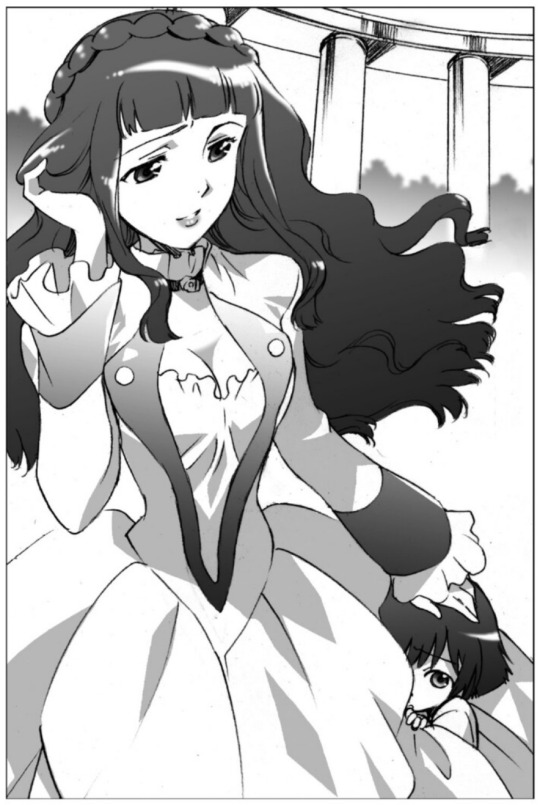
Barely 3year old Lelouch enters the scene! He's entered a shy phase and has to be coaxed to say hi to Cornelia. (But he does do a proper bow and greets her as 'elder sister'!)
Cornelia mentions that Lelouch's shy phase is the total opposite of Euphy who is currently following everyone around 24/7 and being SUPER social no matter the person.
Then, Bismarck comes in. He is holding a crying baby Nunnally and is locked in a vicious circle of trying to get her to stop crying by smiling but having a smile that is too scary to comfort the poor baby. Cornelia laughs at the Knight of One in such a predicament.
Of course, Marianne was the one who forced him to hold the baby despite all his protest that he, who's not even married, would be shit at it. She appears remorseless.
Marianne says she was trying to teach him the stress of a mother who has some maternity nerves due to taking care of two kids, and he's just like. Ma'am the nannies take care of your kids, there is no way you are that exhausted. (He does not say this out loud.)
Beatrice, who has many younger siblings, saves Bismarck and calms down baby Nunnally. Nonette, who likes throwing babies in the air, is banned from approaching the bappy.
Marianne tells the girls to watch the kids for a bit and walks off to talk with Bismarck about serious matters. There's a cute paragraph about the girls helping Lelouch do his first tumble roll and him being really happy about it.
Bismarck muses that not too long ago it would have been unthinkable for there to be the laughter of children in the palace. Marianne teases him that continuing to ensure this is possible is why he's here, isn't he?
Bismarck is Knight of One and also the ONLY Knight of Rounds at this moment. Marianne left the Knights after becoming Empress and the others all died due to the Blood Crest Incident. No new ones have been appointed since.
Bismarck tells Marianne that he thinks she is more suitable to be Knight of One than him.
Marianne doesn't entertain the thought. Bismarck wants more Knights appointed but Marianne says that Charles was ambivalent to the suggestion, being not really concerned about his own safety. Also there are no promising candidates right now.
Anyway, the main reason Bismarck dropped by is because the current Chinese Emperor passed away. This unrest and uncertainty has Charles setting his sides on border expansion and conquering more territory.
Marianne grows pensive. Is Charles good or evil? She's wondered often. We launch into a flashback:

“Your Majesty--do you aspire to be a conqueror?”
Marianne asked him one day, and Charles, laughed happily, which was unusual.
"Hmm...Is that what you see, Marianne?"
"Yes. At least in my eyes."
"Conqueror, huh? If that's what you want, that's not bad either," Charles muttered, an even more amused smile appearing on his handsome face.
When Marianne heard this, her expression turned grim.
“If you are serious about such things, I will refuse to touch His Majesty from now on. Please do not enter my sleeping quarters again. I will immediately decapitate myself.
"I thought you'd say that. But, Marianne, there's one thing you forgot to mention. In that case, you would only kill yourself after beheading this emperor, right? ”
......
"Is it untrue………?"
"Mhm."
"You are a person who never compromises on yourself. Just like me. Therefore, your wings are something that even this emperor cannot control, and the way you flap your wings nobly captures his heart." Marianne couldn't help but smile crookedly as the truth was whispered to her from an unexpected source. Seeing this, Charles also laughed.
"Marianne. My desire is not to conquer the world. It is to strip away the lies of the world. In the process, I hope for the world. I will rid the world of lies. That is my oath. ...But let me promise you this, Marianne. The inside of your heart that you never show to others. That emptiness that cannot be wiped away. Even that, I will make up for it.”
Marianne's expression returned to normal and she fell silent.
Then she said, "If His Majesty truly thinks so, I will create a 'vessel' for His Majesty. His oath, the power to approach it. The path - an army strong enough to conquer the world."
The emperor laughed loudly this time.
"That means you're joining forces with the worst sinner in history, Marianne. Your children and grandchildren will continue to be accused of being witches who assisted the most evil king in the world."
Marianne smiled too.
"Of course, I am prepared. Your Majesty does remember what I am called, right?"
"The Flash. It sounds good, but a flashing light burns people's eyes out. Moreover, your light is by no means the halo of a saint..."
"A bloody hero's death. I have never wielded a sword for anyone other than myself.
"Even when you protected me... that's why I wanted you. Would you like to see the world together, Marianne?''
“Even if it costs me my life.”
Since then she knew.
This person was planning to spread his wings even bigger someday.
Britannia, a continental country. However, this person cannot fit into such a small container. He has to involve many countries and puts the world under its control. Even if he was called a tyrant, or the king of Hades with the sickle of death. Moreover, his motivation was never ambition. Nor was it vigor. Instead it was because of the tears of blood that this person shed when he was young. To fulfill the vow he made. In that case, what she can do after deciding to walk with this person is--
With this cut-off phrase we go back to the present.
In the evening of her meeting with Bismarck, Marianne calls the three girls to meet her. She appears wearing her old Knights of Round uniform and tells them she won't be able to accompany them in their training for a while, so they should use this opportunity to come at her like they mean it because she also won't hold back. For the first time in their sparring, she is dual wielding which was her preferred mode of combat during her active days.
We skip the combat and go right to Marianne coming back out to talk to Bismarck. He remarks that this was quick. The girls stood no chance, though Beatrice held out slightly longer than the others. Marianne asserts that a Knight of the Emperor needs no naivety or kindness so she tried to knock that out of the girls here. She expects they will be changing bit by bit from here on out. Marianne and Bismarck begin to leave for the capital.
Marianne: "Then let's go, Bismarck. To help the king commit the worst crime in history."
Bismarck: "And so it's the return of the empress general."
As they are about to leave a nanny and a crying baby Lelouch stop them. Lelouch had a scary dream during nap time and needed to see his mommy. He had a dream his mother was going very far away.
Marianne tells Lelouch that she isn't going anywhere. But her eyes are cold, as if she was looking at a wooden dummy. Bismarck has seen this expression on her many times before - it's the face she makes before cutting somebody down on the battlefield.
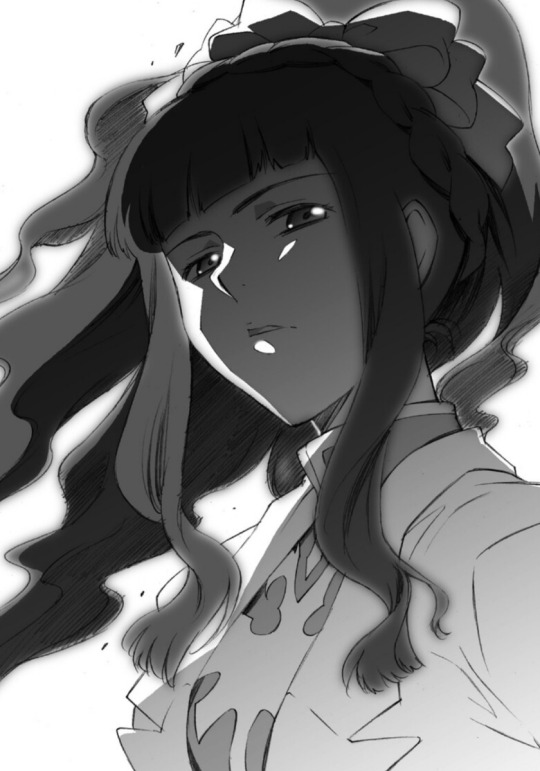
Bismarck is so used to this expression signifying killing intent that his body almost intuitively moves to protect Lelouch - but Marianne just hugs him.
"Lelouch and Nunnally are mother's treasures. I will always be with them and protect them. Forever and ever."
In her heart, Marianne adds: 'However, this is only true so long as you do not stand in the way of he and I.' She suddenly finds baby Nunnally staring at her - she smiles, and Nunnally suddenly trembles as if frightened.
All she can do is stare at her mother's smiling face.
Six months later the Britannian Empire starts its massive expansion campaign, with Marianne The Flash serving as Charles' greatest support.
#code geass#marianne vi britannia#charles zi britannia#het powercouple of all time they make me insane#bismarck waldstein#is also here
45 notes
·
View notes
Text
Shoujo Manga’s Golden Decade (Part 1)
Shoujo manga, comics for girls, played a pivotal role in shaping Japanese girls' culture, and its dynamic evolution mirrors the prevailing trends and aspirations of the era. For many, this genre peaked in the 1970s. But why?

Manga stands as one of Japan's primary cultural exports, deeply ingrained in the local culture and enjoyed by individuals of all ages and genders across various genres. Conventionally, manga is divided into two editorial segments: shonen (targeted at boys) and shoujo (targeted at girls). While shonen manga, propelled by hits like "Dragon Ball," "Slam Dunk," "Naruto," and "One Piece," has achieved global popularity, girls' comics, with their own international sensations such as "Sailor Moon," hold a crucial position in the market. The evolving landscape of girls' manga serves as a fascinating lens through which to observe the shifting fashionable aspirations and beauty ideals within Japanese society.
Shoujo manga has a rich history, dating back to the early 20th century. However, it truly gained recognition in its modern form in the late '50s and early '60s when prominent Japanese publishers introduced shoujo manga anthologies such as Kodansha's Nakayoshi and Shoujo Friend, as well as Shueisha's Ribon and Margaret. The acclaimed "godfather of manga," Osamu Tezuka, is often credited with creating the first modern shoujo, "The Princess Knight," in 1954, and the first shonen, "Astro Boy," in 1952.
A distinguishing feature of shoujo manga is that it is created by and for girls. But, in the '50s, this wasn't the case, and male artists dominated the shoujo field, which was considered an entryway to the manga business. By the 1960s, that would change as publishers recognized that women creators possessed a unique proficiency in crafting narratives centered around female experiences. Female manga-kas resonated with readers in a way that many male artists couldn't, marking a crucial shift in the landscape of shoujo manga.
The Volleyball Craze
A notable display of how shoujo could mirror societal trends unfolded in the '60s. In 1964, the Tokyo Olympics marked a new beginning for post-war Japan, and the female volleyball team, known as Toyo no Majou (the Oriental Witches), achieved stardom by clinching victory in the finals against the Soviet Republic. This triumph triggered a nationwide "volleyball boom," resonating particularly within the shoujo manga realm.
Shueisha's Ribon, historically the leader in the shoujo manga field, started publication in 1955. Still, the editorial house would only begin to make its series available in standalone tankobon format almost 15 years later through the now iconic Ribon Mascot Comics imprint. The first series to be made available by the imprint was Chikako Ide's "Viva Volleyball."
Simultaneously, over at Kodansha, Shoujo Friend was also eager to capitalize on the boom. Editors commissioned a title about the sport from illustrator Akira Mochizuki and novelist Shiro Jimbo. The final project, "Sign wa V," became a multimedia success, being quickly adapted into a live-action TV drama that achieved very high ratings.
While "Viva! Volleyball" and "Sign wa V" enjoyed success in their time, they did not etch themselves into the collective memory. The true shoujo sports manga blockbuster, a cross-generational classic universally known in Japan, is Chikako Urano's "Attack No. 1," serialized from 1968 to 1970 in Weekly Margaret.

It became the first shoujo manga title to surpass ten tankobon volumes (it had a total of 12 volumes), and it was forever immortalized thanks to its 1970 anime adaptation, which reached huge ratings on Japanese TV. Everything about "Attack No. 1" -- from the original manga to the cartoon adaptation to the anime's theme song, which sold over 700k copies as a single -- was a success.
The story of a high school girl trying to become the best player in her school, in Japan, and, eventually, in the world became a phenomenon setting the stage for the '70s "golden era of shoujo."
The Shoujo Lost Years
Until the '70s, manga carried the stigma of being a guilty pleasure, often viewed as a "poison" meant to dumb down young readers. Despite a few discerning individuals recognizing the medium's potential, manga critics, enthusiasts, and tastemakers — predominantly men — largely disregarded female-centric comics. Shoujo manga, despite its immense popularity, faced the harshest criticism.
Because society and critics downplayed shoujo, influential shoujo manga-kas from the '50s and '60s, such as Hideko Mizuno, do not enjoy the same level of recognition as their shonen counterparts from that era.

Hideko Mizuno and a page of one of her most celebrated works, "Fire."
Mizuno was one of the first women to create manga, worked as an assistant to Osamu Tezuka, and was behind several massive hits that had a significant impact on women in the '50s, '60s, and '70s. In fact, the most iconic shoujo manga-kas from the '70s golden period directly mention her as an influence. She fought to include romance -- now the essential element in girls' manga -- in her works back when such topics were deemed inappropriate by male editors.
Mizuno's repertoire was vast: she wrote mangas about little girls and their poneys, magic adventures, and romcoms based on Audrey Hepburn's movies, and she drew the first sex scene in a shoujo manga. The manga in question was "Fire," a teen-targeted manga featuring a rebellious American rocker, which broke new ground by having a male character as its focal point. Alongside other notable female artists from the '60s, Mizuno laid the groundwork for the '70s shoujo explosion, during which girls' comics took center stage.

In 1960's "Hoshi no Tategoto" (left,) Hideko Mizuno created the first shoujo love story. Serialized in Weekly Margaret between 1964 and 65, "Shiroi Troika," set during the Russian Revolution, was the first historical shoujo manga.
A contributing factor to this "golden period" was the emergence of several shoujo mangas as unstoppable hits, selling millions of copies and becoming cultural phenomena. These titles, considered masterpieces, continue to be read and known by multiple generations.
The BeruBara Boom
"Attack No. 1"'s success spread far and wide, forcing Japanese society to take note of the potential of the shoujo segment. Right after this historic success, Shueisha's Weekly Margaret hit the jackpot once again with another epoch-defining manga hit, Ryoko Ikeda's "The Rose of Versailles," which debuted in 1972. Set in the years preceding and during the French Revolution, it weaved together historical figures like Marie Antoinette and fictional ones, like the iconic Lady Oscar, a handsome noblewoman raised as a boy to succeed her father as the commander of the Royal Guard at the Palace of Versailles.

The first volume of the original comic had Marie Antoinette on the cover as Margaret's editors believed she'd be the favorite character. However, the androgynous Lady Oscar turned into a fan fave and the absolute star of the series, which is reflected on the cover of most rereleases since then, including the 2013 bunko version seen above.
When talking about shoujo manga classics from the '70s recognized by literally everyone in Japan, "Rose of Versailles" is probably the first name that comes to mind. It was a hit that really defined the era and impacted the country as a whole. While Marie Antoinette is seen around the world as a tragic, out-of-touch figure, in Japan, many women and girls see her as an aspirational historical fashion icon. While Sofia Coppola's 2006 film "Marie Antoinette" solidified this among younger generations, it was Ikeda's gentle portrait that made her a character loved by so many across all age groups.
When conceptualizing the story, Ikeda was heavily inspired by Stefan Zweig's "Marie Antoinette: The Portrait of an Average Woman," which she read while in high school. Once in college, in the late '60s, she, like millions of others, was heavily involved with the Marxist student movements. These references led to a historical romance that touched on heavy and revolutionary themes, which was atypical for a shoujo manga, a segment that, back then, was primarily catered to elementary school-aged girls.
Because of its unorthodox concept, Margaret's editors were unsure about the series. But right from the start, "BeruBara" (derived from the original Japanese title, "Berusaiyu no Bara"), serialized between 1972 and 1973, was an explosive hit, quickly turning into Weekly Margaret's most popular series. It was compiled in 10 tankobon volumes published, which sold tens of millions of copies.
In 1974, after the original manga had finished its serialization, Takarazuka Revue, an all-female theatrical troupe, announced a stage adaptation of the story.
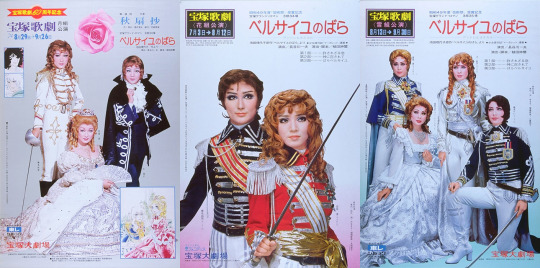
Posters of the first three Takarazuka adaptations, from between 1974 and 1975. Since then, the Revue has adapted the manga 11 times, with a new run scheduled for 2024.
The Revue was established in 1913 by the owner of Kansai's leading railway company, Hankyu, to boost tourism to the city of Takarazuka, his line's last stop. It was a huge success, and soon, the group had its own luxurious theater as well as its very exclusive academy where young ladies underwent an arduous audition process to become Takaraziennes. In 1934, a second Takarazuka theater opened in Tokyo.
However, in the early 1970s, Takarazuka faced stagnation, with declining ticket sales attributed to the growing popularity of alternative entertainment forms such as cinema and television.
In 1973, Shinji Ueda, who had risen through the Takarazuka ranks as a director, made his debut as a playwriter in the company with a musical based on ancient Japanese history. While thinking about his next project, he decided to check out a manga popular with some Takarazuka fans, "Rose of Versailles," and he quickly realized it was the perfect theme for an adaptation. Lady Oscar, who had lady-like features but was also as handsome as a man, was the embodiment of the male role-playing Takaraziennes. Ueda reached out to Ryoko Ikeda, who, as an admirer of the troupe, quickly granted the rights.
But Ikeda and Ueda's excitement wasn't shared by many. Most of the Takarazuka team were skeptical about a play inspired by something as vulgar as a manga. Fans of the original were also highly protective of its characters and entirely against a live adaptation.
Amid this climate of distrust, the play opened at the end of August 1974 at the Takarazuka Grand Theater. The reaction after the first night was extremely positive. Soon, Takarazuka's "Rose of Versailles" was the hottest ticket in all of Japan, with the press breathlessly covering the "BeruBara boom" that led thousands of people to stand hours in line to get tickets to the coveted performances in Kansai and Tokyo. Ikeda herself was shocked by the media phenomenon when she returned from an overseas trip and had hundreds of reporters awaiting her at the airport.
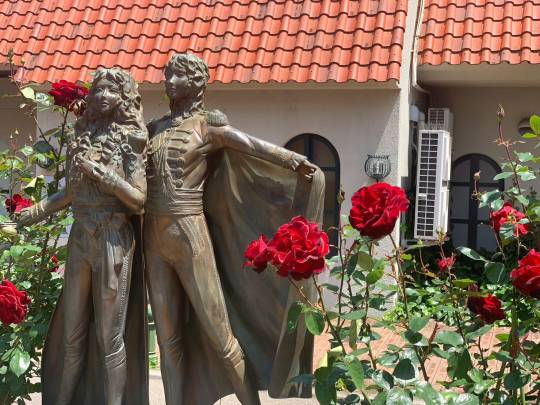
A statue of Lady Oscar and Andre surrounded by rose bushes sits outside the Takarazuka Grand Theater in Hyogo, Japan.
The "BeruBara" phenomenon single-handedly reversed Takarazuka's fortunes, leading to record-shattering ticket sales for the company. The Takarazuka Academy, which had seen declining applicants, suddenly became highly sought-after again, originating the saying "Todai in the East, Takarazuka in the West," comparing it to Tokyo University, the most prestigious university in Japan. The phrase underscored the desirability and prestige associated with a position at the troupe.
Ultimately, the success of "The Rose of Versailles" propelled Takarazuka back to the pinnacle of the entertainment industry, a position it maintains to this day. The brand continues to hold great esteem among women of all ages in Japan, with Takarazuka's stage adaptations, derived from Broadway musicals, movies, novels, and shoujo manga, consistently selling out. Notably, various adaptations of "BeruBara" have collectively sold over 5 million tickets since 1974.
Following the manga and Takarazuka adaptation's explosive success, the anime debuted in 1979. While the anime received acclaim, Ikeda herself was not entirely satisfied, mainly due to the treatment of her favorite character, Andre, who played a significant role in the manga but had a minor presence in the animated version, which focused almost entirely on the manga's most popular character, Lady Oscar.

In 2013, celebrating Margaret's 50th anniversary, new special chapters of "BeruBara" were published. The first new story in 40 years resulted in Margaret magazine selling out across the country.
"BeruBara" remains a prominent franchise in Japan, spawning numerous licensed products, sequels, and spin-offs. Ryoko Ikeda, known for other successful series, continues to garner widespread respect and media attention. However, while almost everything related to "The Rose of Versailles" turned into a hit, there was an exception.
In March 1979, a few months before the anime premiere, a live-action film adaptation debuted with great fanfare. Fittingly for such a hot property, the movie was one of the most ambitious productions in Japanese cinema, with a substantial 1 billion yen budget.
The Palace of Versailles granted permission to shoot in its interior. The film was filmed in English, with a European cast. The project was helmed by France's hottest movie director, Jacques Demy. Demy wasn't respected only in the West but also in Japan, where his two most important films, "The Umbrellas of Cherbourg" (1964) and "The Young Girls of Rochefort (1967)," were also hits. In fact, to this day, both flicks remain popular among trend-conscious Japanese as examples of stylish oshare movies that fully capture aspirational girls' culture (alongside, among others, Sofia Coppola's "Marie Antoinette"). Demy, the mind behind dreamy, girly movies, seemed like the perfect choice to turn this blockbuster shoujo classic into a live-action film.
The movie had the backing of three gigantic domestic corporations: Toho, the leading Japanese movie distributor; Nihon Terebi (NTV), one of the main TV stations; and cosmetic giant Shiseido. NTV and Shiseido made sure the movie had one of the most extensive marketing campaigns Japan had ever witnessed. The TV station aired specials and segments on this grand production. Meanwhile, Shiseido made the star of the movie -- British actress Catriona McCall, who played Oscar -- the face of its spring campaign, promoting its new Red Rose lipstick. Catriona was plastered on billboards across the country, made media and department store appearances, and starred in luxurious TV spots.

On the left, Lady Oscar and Marie Antoinette adorn the cover of Margaret in 2016, over 40 years after the end of the original serialization. On the right, Oscar models Dolce & Gabanna new collection for high-end fashion magazine Spur in 2014, celebrating 40 years of the conclusion of the original manga.
Back then, Kanebo, the second biggest local cosmetic company, was in fierce competition with Shiseido. TV ads from both companies had a tremendous impact, propelling singles to the top of the charts, and there was a battle on which commercial would feature the biggest hit. But, in the spring of 79, the focus of the fight changed. As a response to the Catriona "Rose of Versailles" campaign, Kanebo also hired a British beauty, actress Olivia Hussey, and launched a "Super Rose lipstick" with the tagline "You are more beautiful than a rose." The cosmetics war was another proof of the chokehold "The Rose of Versailles" had in the decade.
But, when the movie finally premiered, it was a flop. Critics hated it. Japanese fans thought the adaptation was weak and lacked impact. Catriona, in particular, was very criticized for not conveying Oscar's androgynous charm, which perfectly balanced masculinity and femininity. With the well-received anime premiering just a few months later, the expensive movie adaptation ended up being outshined and forgotten. It became only a costly footnote in its history.
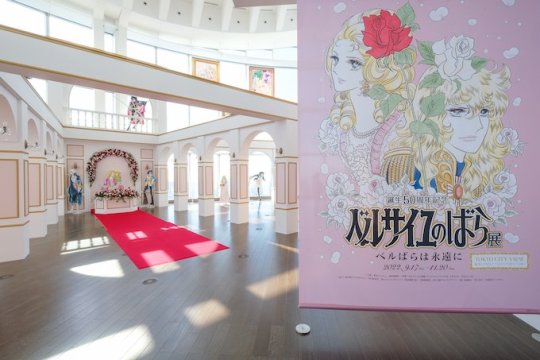
An exhibition in Tokyo celebrates 50 years of BeruBara in 2022.
(It's worth noting that Kanebo clearly won the CM war. The "You Are More Beautiful than a Rose" song they commissioned from singer Akira Fuse became a considerable hit).
Movie aside, "The Rose of Versailles" is one of Japan's most beloved comics. From its debut in 1971 to its film and anime adaptation in 1979, it remained front and center in the country's mind throughout the whole decade. Its impact was felt in different fields, from the cosmetic business to the publishing business, from live theater to TV. It also forever changed how shoujo manga was perceived and remains one of the country's most beloved properties.
Ace-Scoring Manga
The 1970s marked a turning point for shoujo manga, as it began to gain recognition beyond its traditional audience, propelled not just by critical acclaim but by commercial success. The era witnessed the emergence of several blockbusters that captured the public's imagination. Notable among them were Yoko Shoji's "Seito Shokun," a tale centered on the daily exploits of a mischievous high-schooler, and Waki Yamato's "Haikara-san ga Toru," a love story set in the Meiji period featuring a tomboy with a lady-like demeanor. These manga were significant hits during their publication in Shoujo Friends, becoming best-selling titles.
Some shoujo classics from the '70s are still in publication today, appealing to a diverse readership spanning multiple generations. Suzue Michi's "Glass Mask," serialized in Hana to Yume since 1976, remains a cultural phenomenon with 49 tankobon volumes, over 55 million copies sold, an anime adaptation, a live-action drama, and a stage play. Similarly, Chieko Hosokawa's "Crest of the Royal Family," chronicling the adventures of a young American girl transported to ancient Egypt, has been a consistent presence in Princess magazine since 1976, boasting 69 volumes and over 45 million copies sold to date.
But, when talking about definitive shoujo classics from the '70s, titles that were historical successes, influenced everything going forward, and are known by everyone, three titles come to mind. We already explored one of these, "The Rose of Versailles." One of the other three is "Ace wo Nerae."

Following the monumental success of "Attack No. 1," the prospects of another shoujo sports manga achieving similar heights of popularity seemed improbable. However, Weekly Margaret defied expectations once more in 1973 with the release of Suzumika Yamamoto's "Ace wo Nerae" ("Aim for the Ace"), a compelling narrative focused on tennis that swiftly captured the nation's attention.
Japan and tennis already had some prior history. The first Japanese Olympic medalist was a tennis player, Ichy Kumagae, in 1920. Emperor Akihito met his commoner wife, Michiko, at a tennis match, and they initially bonded over their love for the sport. But, in the 70s, the country was taken over by an unprecedented tennis boom. At high schools across the nation, tennis became the most popular after-school activity. Fashion magazines like JJ and Popeye dedicated pages and pages to "tennis fashion." At the same time, trendy young adults decked in clothes from sports brands populated Shibuya and other stylish districts in Tokyo.
There were several contributors to the tennis boom. But the remarkable success of "Ace wo Nerae," which first conquered girls before dominating the nation, played a part in it.
The manga follows the journey of Hiromi Oka, a high school student initially plagued by insecurities but propelled into the world of tennis through the encouragement of her coach. "Ace wo Nerae" portrays her growth from a hesitant newcomer to a world-class tennis player, navigating challenges and discovering hidden potential along the way.

From left to right: Madame Butterfly, lead character Hiromi Oka and coach Jin Murakata as depicted in the anime. Madame Butterfly, a rich wealthy student who was gentle and a world-class tennis player, is a fan favorite character.
In 1973, "Ace wo Nerae" was adapted into an anime. Despite initial modest ratings, the anime gained popularity through reruns. Encouraged by this, NTV decided to remake the cartoon. The second adaptation, which debuted in 1978, was an immediate hit. Concurrently, Weekly Margaret revived the manga series, which, after being first finalized in 1975, ran again from 1978 to 1980, spanning a total of 18 volumes.
Since "Ace wo Nerae," several hit mangas focused on tennis -- both shoujo and shonen -- were published. But, thanks to the success of its anime and the intragenerational support for the manga, the original work by Suzumika Yamamoto is still considered one of the defining and most beloved works about the sport. Its role in propelling tennis culture as part of the oshare youth culture of the '70s also defines its impact.
Japan Wants Candy
Following the monumental multimedia success of "The Rose of Versailles" and "Ace wo Nerae," the third shoujo sensation of the '70s is "Candy Candy."

Initially published in Nakayoshi, the story started taking shape when editors at the magazine sought a work of literary excellence akin to beloved classics popular among girls, like "Heidi" and "Anne of Green Gables." They enlisted Keiko Nagita, writing under the pen name Kyoko Mizuki, and paired her with one of the magazine's most famous artists, Yumiko Igarashi. The collaborative effort resulted in the creation of "Candy Candy," centered around an American, blond, blue-eyed orphan named Candice "Candy" White Ardlay.
"Candy Candy" epitomized various shoujo directions prevalent in the '70s. The protagonist, a white girl with lustrous blonde hair, embodied the fascination with Western culture during a time when Japanese youth held a keen interest in Europe and the United States. The manga's narrative style, characterized by its dramatic tone and intricate plot twists, also aligned with the prevalent storytelling preferences of the era.
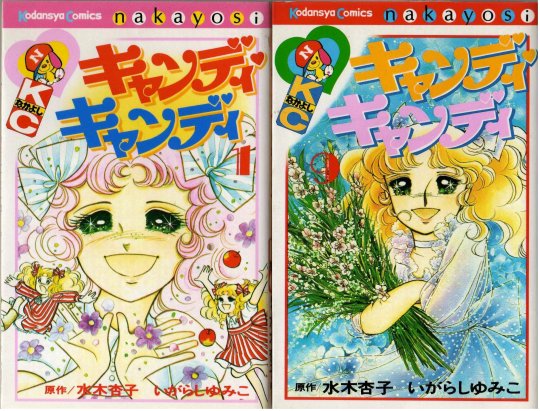
Candy Candy was such a resounding success that it became the first manga to achieve an initial print run of over 1 million copies of one of its paperback compilations.
Debuting in 1975, "Candy Candy" swiftly captured the hearts of Nakayoshi's readers, leading to unprecedented success. The subsequent anime adaptation by Toei in the following year propelled the franchise into the realm of a cultural phenomenon, sending manga tankobon sales skyrocketing. The seventh volume of the "Candy Candy" compiled paperback reportedly became the first Japanese manga to achieve an initial print run of over 1 million copies. Additionally, Nakayoshi's sales surged, surpassing those of Shueisha's Ribon for the first (and only) time.
The adventures of young Candy were also licensing gold. With over 100 licensed products, the "Candy Candy" doll alone sold 2 million units, solidifying Bandai's position as Japan's premier toymaker, a status it continues to uphold to this day. The resounding success of "Candy Candy" forged a lasting alliance between Kodansha's Nakayoshi, Toei Animation, and toymaker Bandai, which led to the iconic "Sailor Moon" franchise in the 1990s.
While "Candy Candy" concluded its run in 1979, its appeal extended far beyond its original target demographic, captivating kids, teenagers, and adults alike, thus contributing significantly to the manga and anime's widespread acclaim and enduring popularity.
However, a protracted legal dispute between Igarashi and Nagita has prevented the commercialization of any "Candy Candy" related products since the late 1990s, including reprints of the manga and re-broadcasting of the anime. The lawsuit arose from Igarashi's unauthorized licensing of merchandise based on the franchise, falsely asserting sole ownership of the copyright. Although Igarashi was initially credited as the lead artist in Nakayoshi during the manga's publication, the court ultimately ruled in Nagita's favor, emphasizing that Igarashi's artistic foundation was built upon Nagita's written work.
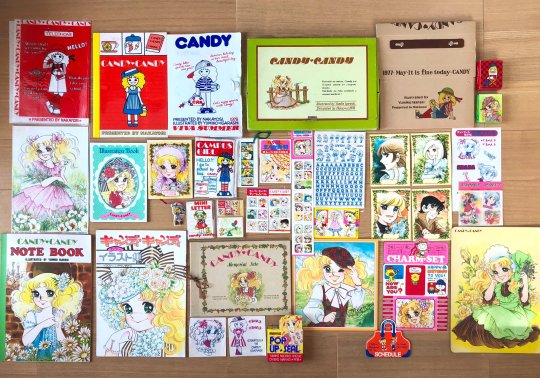
A collection of "Candy Candy" freebies offered by Nakayoshi magazine in the '70s. During the publication of the series, Nakayoshi would eclipse Ribon's sales for the one and only time in its history, (image credit)
Consequently, any commercial exploitation of Yumiko Igarashi's "Candy Candy" artwork necessitates the approval of both Igarashi and Nagita, a challenging prospect given the existing feud. Nagita, on the other hand, can profit from "Candy Candy" as long as she doesn't include any illustrations, which allowed her to release a book sequel in 2010. However, due to the dispute, one of the most beloved works in Japanese manga history is currently out of print. The lawsuit also blocks the anime from being aired or distributed. But, despite the almost two-decades-long media ban, "Candy Candy" remains widely known and beloved across Japan, a testament to its staying power.
While smash hits like "Candy Candy," "Ace wo Nerae," "Rose of Versailles," "Seito Shokun," "Hikara-san ga Tooru," and "Glass Mask," among others were key pieces into shoujo finally earning the respect it deserved, the rise of a revolutionary group of artists during the '70s was another critical element in shoujo's rise: the Year of 24 Group.
Part 2
#1970s japan#1970s#vintage shoujo#shoujo manga#lady oscar#rose of versailles#ace wo nerae#candy candy
45 notes
·
View notes
Text
104th Hop Step Award - H☆S (October, 1993)
Togashi-sensei's Direct Instructions! The road to conquer all areas of manga!
Mass Recruitment for the 104th (October 1993 Term) H☆S Award!! This month's judge is Yoshihiro Togashi-sensei!

The Hop☆Step Award (H☆S Award) was a monthly recruitment project by Weekly Shonen Jump (Shueisha) that took place from March 1985 to July 1996.
I already translated Togashi's ten "4-koma" that he drew during the Yu Yu Hakusho serialization to give advice to the participants of the H☆S Award - October 1991 & 1992 Terms.
This time, I am translating the October 1993 Term, where he gives the newcomer manga artists more tips and advice on how to create different styes of manga. The winner of this edition was Eiichiro Oda with the one-shot "Ikki Yakō" (一鬼夜行). At the time, Yu Yu Hakusho was in the Black Chapter Arc.
Togashi gives instructions to help creating gag, love comedies, sports and fantasy manga. He used a little bit of all those elements in Yu Yu Hakusho.
Part 1. Gag Manga

T/N: Chain letters (letters of misfortune) were popular in Japan during the Showa era. A ''letter'' or ''postcard'' was delivered to your home/work in the style of ''If you do not send it to a certain number of people, you will be unhappy.'' The sender is unknown. Chain letters were also a hot topic in magazines and manga, like Doraemon and a bunch of gag manga.

Source: Weekly Shounen Jump N°44, 1993. Shared by katsura_00
The funny versions of Yanagizawa, Kido and Kaito represent the editors in charge of:
Jungle King Tar-chan/DNA² (Kaoru Kushima);
Lucky Man/JoJo (KAITO Katsuhiko);
Yu Yu Hakusho/Monmonmon (Tomoyuki Shima)
Waiting for powerful works that will break these guys territories! !

They were responsible for the screening, checking all the applications and eliminating the mediocre works before passing them on to Togashi. Inside their territories, works with "characters that are all very similar," "characters with no strong personality at all" or "just imitations of existing characters" were mercifully discarded.
Part 2. Romantic Comedy


Source: Weekly Shounen Jump N°45, 1993. Shared by katsura_00
Part 3. Sports Manga


Source: Weekly Shounen Jump N°46, 1993. Shared by katsura_00
Part 4. Fantasy Manga

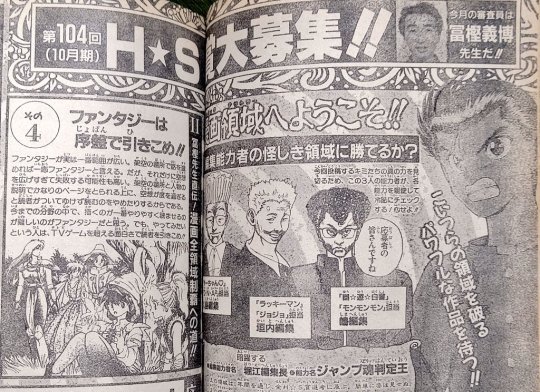
Source: Weekly Shounen Jump N°47, 1993. Shared by katsura_00
T/N: The fantasy illustration of Botan, Keiko, Yukina, Shizuru and Atsuko in medieval clothes was designed to the opening page of Yu Yu Hakusho volume 11, tankobon edition.

🏆 Winner: Eiichiro Oda
Oda-sensei was the inner of this edition! Togashi-sensei reviews his 31-page one-shot, "Ikki Yakou", that was published in the 1994 Shonen Jump Spring Special, and later reprinted in 1998 as part of Wanted!, a compilation of Oda's pre-One Piece stories.

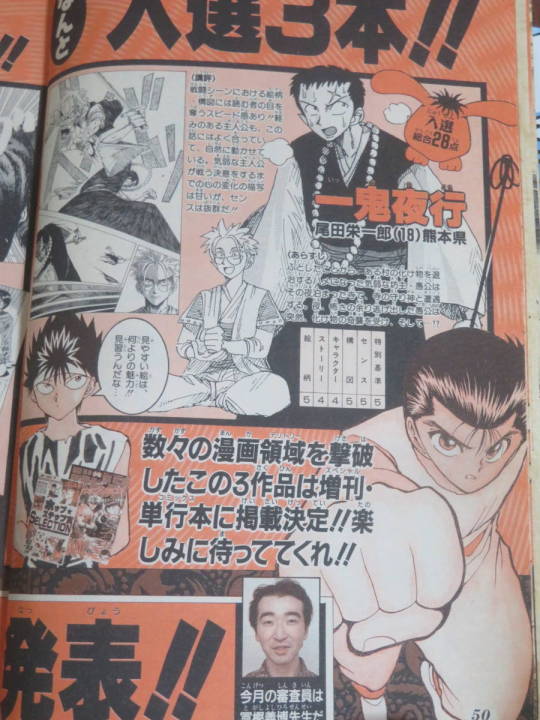
Source: Weekly Shounen Jump N°2, 1994
#Yoshihiro Togashi#Yu Yu Hakusho#hop step award#Weekly Shounen Jump#1993#H☆S Award#gag manga#romantic comedy#Eiichiro Oda#sports manga#Togashi's advice#一鬼夜行#Night Parade of One Demon#fantasy manga
31 notes
·
View notes